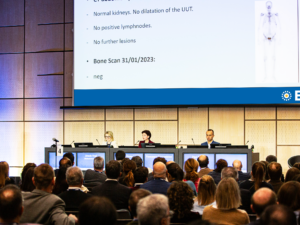EMUC19 is a meeting that attracts a wide variety of supplementary meetings, either from EAU Sections like ESUI (Imaging), courses by the European School of Urology, or highly-specialised symposia like the EMUC Symposium on Genitourinary Pathology and Molecular Diagnostics, or ESUP Symposium for short.
The symposium is co-organised by the EAU Sections of Uro-Pathology (ESUP) and Urological Research (ESUR) and the Uropathology Working Group of the European Society of Pathology. Expert speakers were drawn from these bodies, with speakers of a variety of pathology-related backgrounds.
This year, the ESUP Symposium examined the current state of liquid biopsies in uro-oncology, and it possible future applications. What emerged over the course of the afternoon was a future with a promising perspective, but still a lot of work to be done for researchers and pathologists.
Dr. Michelangelo Fiorentino (Bologna, IT), a clinical pathologist, gave an introductory talk on the current applications, and what uro-oncologists should know before using them. Liquid biopsies refers to the use of blood and other bodily fluids as an alternative to tissue samples for diagnostic purposes.
The potential of liquid biopsies is significant, according to Fiorentino: “The major advantages are the non-invasiveness, removing the need for biopsies. Also, liquid biopsies can give a better representation of all the tumour profiles and genetic mutations. Finally, liquid biopsies can give a better indication on the extent of tumour burden.”
In theory, any lab test for tissue can be used to analyse liquids, but they have to be adapted for much lower concentrations of tumour cells. Some tests can require up to 80ml of blood. As it stands, liquid biopsy is currently much more expensive than conventional histology. The reliability of diagnostic accuracy is also inferior. It is also not entirely clear which professional should be in charge of liquid biopsies: pathologists, biochemists, geneticists or (uro-)oncologists.
Potential for BCa
Following talks on kidney cancer (by ESUR Chairwoman Prof. Kerstin Junker, pictured) and prostate cancer and the potential suitability of liquid biopsies for those urological cancers, Prof. Thomas Gevaert (Leuven, BE) spoke on bladder cancer. “In contrast to other urological cancers, BCa has advantage: we can look at blood as well as urine. By combining analysis of the liquids, and with a variety of techniques we can investigate different substances.”
“The majority of patients with metastatic BCa have circulating tumour DNA. This means there is potential value to stratify patients for clinical trials, as well as potential value in diagnostic and follow-up flowcharts. cfDNA/ctDNA is a very sensitive tool to detect early recurrence and minimal residual disease.”
Gevaert postulated that by combining analysis of cfDNA (mutational landscape) and CTC’s (protein expresession), these could be complementary tools with even better results.
Despite aforementioned advantages of liquid biopsies, particularly for BCa, like its non-invasiveness, the combination of urine and blood, and the pre-screening and monitoring, Gevaert pointed out certain hurdles that need to be cleared before liquid biopsies are adopted.
“As with many new techniques, we are still waiting for prospective validation. We also need standardization in our approach. Crucially, we should not be using liquid biopsies unless there is a clear superiority when compared to traditional biopsies. Sensitivity and specificity of liquid biopsies also need to be determined.”





